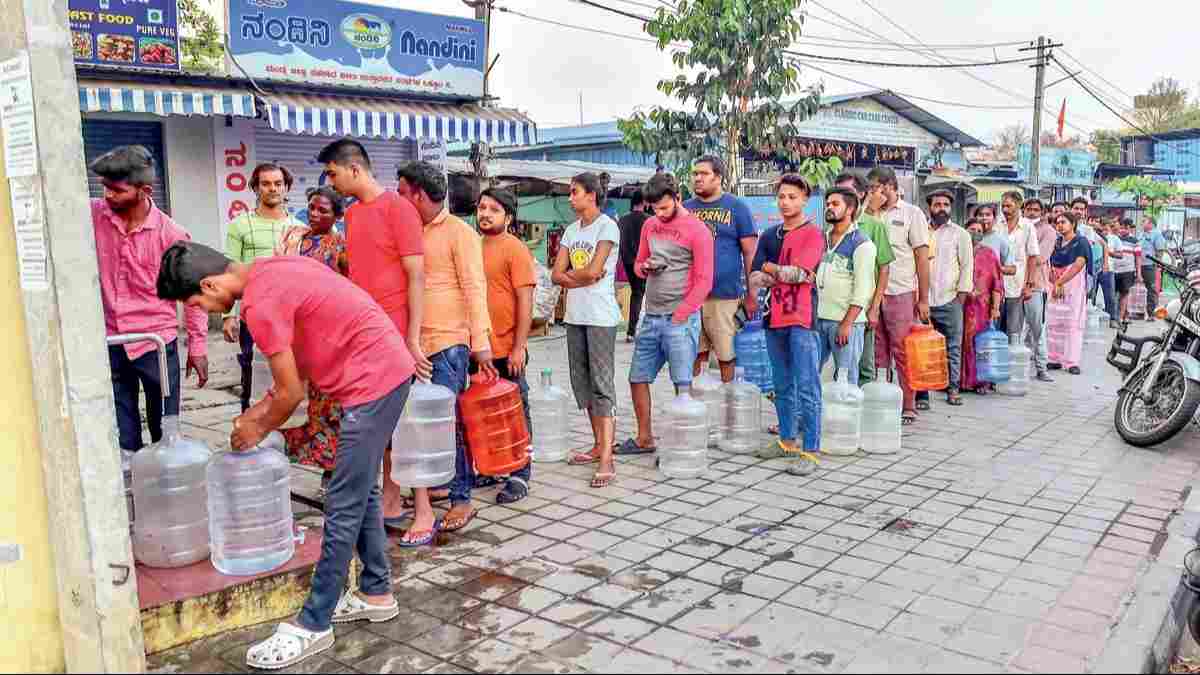Water crisis in Bangalore: A tale of two worlds. Contrasting urban piped supply with rural groundwater depletion amid soaring demand.
Among the hectic roads, and sky-scrapering buildings of Bangalore, a very serious issue exists – the water crisis in Bangalore. This city, yet still, called the Silicon Valley of India, is confronting an extraordinary challenge that transcends from the boundaries of the metropolis. From the urban life in Bangalore to the rural settlements, the prolonged stress of water scarcity looms over both livelihood and ecosystems.
The Bangalore Conundrum: Water Crisis in Bangalore
The water crisis in Bangalore has been in the media limelight, with headlines decreeing the pressing need for intervention. Karnataka’s Chief Minister, Siddaramaiah reiterated the degree of emergency presenting a situation where the daily requirement of 500 million liters is not available – which is a third of the city water demand. Due to this, there are steps taken to reduce the pressure on the water bodies of Bangalore.
Beyond Bangalore: The Spreading Regional Effect
However, the effects of the water crisis in Bangalore go beyond the city, bringing Karnataka and surrounding areas like Telangana and Maharashtra to the core. The acute shortage, coupled with the deleterious effect of the deficient monsoon of the previous year that has further intensified the crisis, makes people in the region feel helpless as water supplies dwindle.
Rainfall Deficit: A Spark of Water Crisis in Bangalore
Bangalore is facing a water shortage because Karnataka experienced heavy drought in the previous rainfall season. The state was baffled by an 18% precipitation drop from normal, leading to the state’s severe drought that couldn’t fill up reservoirs and aquifers. The deficiency of rainfall, the forerunner of drought, paved the way for the crisis that was to be.
Reservoirs in Retreat: Bangalore’s Vulnerable Situation
Unfortunately, in the background of insufficient rainfall, Bangalore’s reservoirs go dangerously empty. Right now, these precious sources of water which are supposed to be this full at this time of year, hold only a 26% level. In the face of an unforgiving summer, Bangalore’s water infrastructure is being put to the severe test.
Urban vs.Rural Realities: Unveiling Disparities
Cities like Bangalore depend mainly on the piped water supply system, on the other hand, it is the rural area that faces the harsh reality of the water crisis in Bangalore as they lose their groundwater reserves. Increasing pressure on households, agriculture, industry, and hydropower sectors in the dry summer makes the gap between urban and rural water access more evident.
Structural Issues Compound Crisis: Water crisis in Bangalore
Experts attribute the serious water crisis in Bangalore to the combination of many long-term structural issues such as uncontrolled urbanization, degradation of natural bodies of water, and climate change which is a specter. Nevertheless, the direct causes are linked to seasonal rainfall variations and a lack of state support to strengthen the water management infrastructure.
Toward Resilience: Mapping the Way Forward
While Bangalore is still reeling from the short-term effects of the crisis, it is also now more important to consider measures for the longer-term future. At the core is the understanding that water is limited, thus necessitates policies that support sustainable usage and discourage waste.
Conclusion
Ultimately, the water crisis in Bangalore is a stark manifestation of the vulnerability of our water resources, which demands immediate cooperation from all parties. In the face of adverse winds, as stakeholders join efforts and strive to navigate through the storm, the trip to a resilient and sustainable future starts with every drop of proactive action.
Through this article, we want to show you how the Water crisis in Bangalore is spread.


